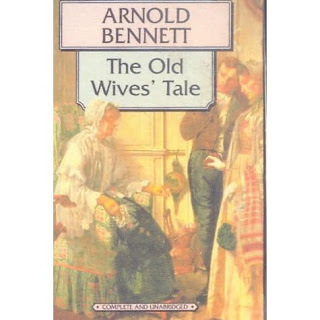My review of The Old Wives' Tale, by Arnold Bennett

First published in 1908, this is considered one of Bennett'sfinest works. His breathtaking detail and description is something to behold.
The story begins around 1840 in the Stafforshire potterytown of Burslem, where young sisters Constance and Sophia Baines work in theirparents' draper's shop. They are initially close but contrastingly differentgirls, Sophie the younger considered incorrigible by the more proper Constance.As they grow up the girls drift, mentally and geographically, apart. Later alsoset partly in Paris, the tale tracks each sister, separately, into the fullbloom of adulthood, the prime of maturity and the frailty of their dotage. Itconcludes in 1905.
The book divides into four parts. The first, 'Mrs Baines',introduces the two sisters and those around them, in their bedridden father'scombined shop-cum-house overlooking the town square. With their father ill, thesisters' primary parent is their mother. By the end of this section, rebelliousSophia has eloped with a travelling salesman, while obedient Constance hasmarried her parent's shop employee, Mr Povey.
The second part, 'Constance', follows sensible Constancethrough to her grey-haired retirement, when she reunites with her long-lostrunaway sister. Her unremarkable life is defined not by adventure oroutstanding accomplishments, but by deeply personal events, such as herhusband's death, her growing worries over her son's life decisions and socialbehaviour.
The third part, 'Sophia', follows passionate young Sophiaafter her elopement. Deserted in Paris by her husband, she survives the odds,becoming a successful pensione proprietor.
The fourth part, 'What Life Is', sees the two sistersreunite. Worldly old Sophia finally returns to her Burslem childhood home,which plain old Constance has never left.
It's mindboggling that one man could have created so muchintricate detail in these wonderful Victorian characters. How on earth did heachieve this?
In his initial published introduction, Bennett mentioned hisdebt to Guy de Maupassant's Une Vie (that same introductionoriginally included a nod to W. K. [Lucy] Clifford's Aunt Anne, buther mention is intermittently omitted from various subsequent editions and ispermanently absent by the 1983 edition). Bennett's inspiration for the actualstory was triggered by a chance encounter in a Paris restaurant, as herecounts:
'...an old woman came into the restaurant to dine. Shewas fat, shapeless, ugly, and grotesque. She had a ridiculous voice, andridiculous gestures. It was easy to see that she lived alone, and that in thelong lapse of years she had developed the kind of peculiarity which inducesguffaws among the thoughtless.
I reflected, concerning the grotesque diner: "Thiswoman was once young, slim, perhaps beautiful; certainly free from theseridiculous mannerisms. Very probably she is unconscious of her singularities.Her case is a tragedy. One ought to be able to make a heartrending novel out ofthe history of a woman such as she." Every stout, ageing woman is notgrotesque — far from it! — but there is an extreme pathos in the mere fact thatevery stout ageing woman was once a young girl with the unique charm of youthin her form and movements and in her mind. And the fact that the change fromthe young girl to the stout ageing woman is made up of an infinite number ofinfinitesimal changes, each unperceived by her, only intensifies the pathos.'
Perfect in every way, I have never read anything in thiscategory that surpasses this in literary quality or storytelling. Why this isnot more famously celebrated I can't imagine. No major updated screen adaptionhas eventuated since the 1921 film The Old Wives' Tale starringFay Compton, Florence Turner and Henry Victor, other than the 1988 BBC TVseries Sophia and Constance starring Alfred Burke, LynseyBeauchamp and Katy Behean.
I adore this oft overlooked great classic. Everyone shouldread it at least once in their life.



